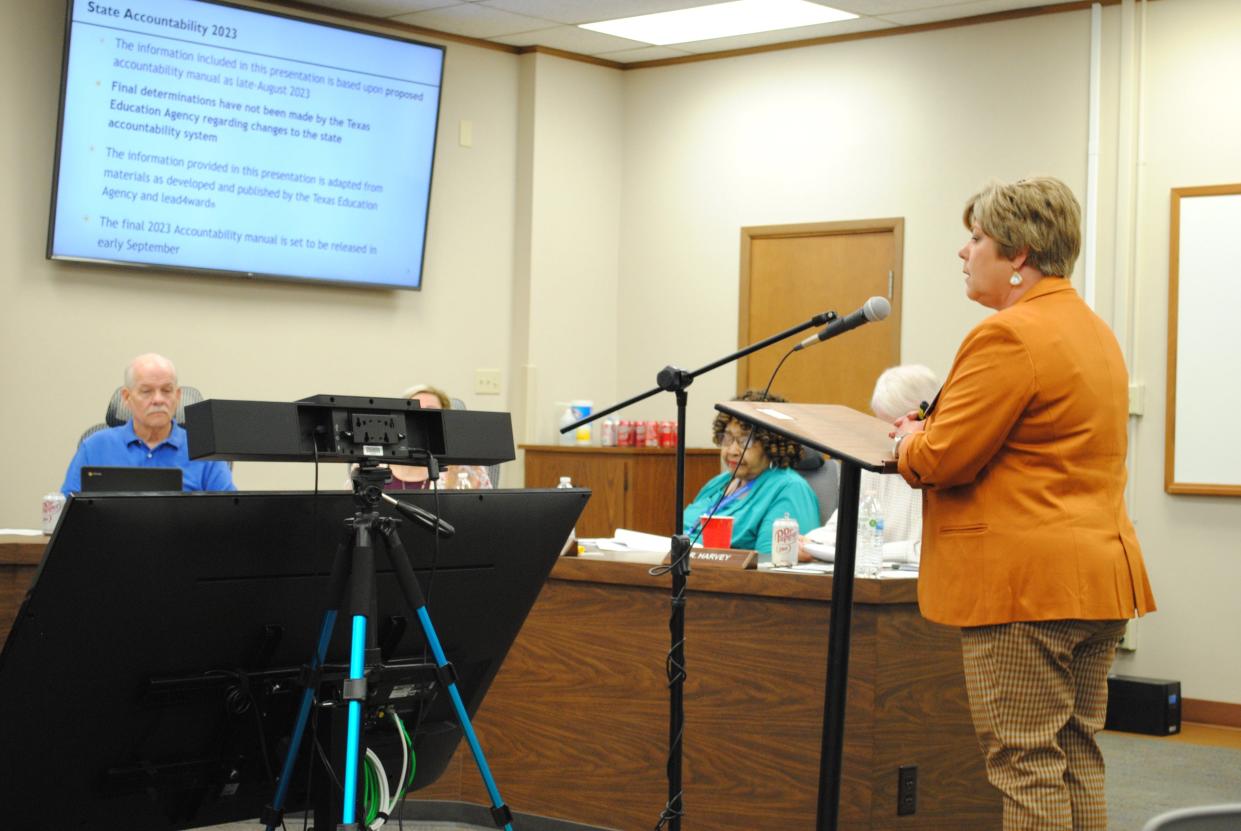Wichita Falls ISD board previews proposed revamp of TEA accountability

On the same day the Wichita Falls ISD board of trustees received a presentation about potential changes in the Texas Education Agency accountability system, the TEA announced a delay in the release of the 2023 ratings.
According to a release Tuesday from TEA, ratings for districts and campuses across the state were scheduled to be released Sept. 28, but that date has now been pushed back approximately one month. The delay, the TEA said, is to re-examine the “baseline data used in the calculation of Progress to ensure ratings reflect the most appropriate goals for students.”
The TEA ratings are even more pressing this year for Wichita Falls ISD as an Improvement Required rating related to Kirby Middle School for another year could mean possible state takeover. However, if Kirby passes they may be able to start over with a clean slate of accountability.
WFISD Superintendent Donny Lee said the district will communicate with parents about TEA's delayed announcement and continue with their plans as normally scheduled.
More: A-F ratings figuring largely in district's fate to be discussed at Tuesday's WFISD meeting
Texas State Teachers Association President Ovidia Molina bemoaned the TEA's retroactive recalculation of a key element in accountability — districts’ college, career and military readiness — saying the move will significantly lower many districts’ ratings.
“The state also must find a more meaningful evaluation system for our schools, one that is no longer dominated by STAAR test scores, which also still play a major role in determining accountability scores,” Molina said.
A presentation Tuesday by Micki Wesley with the Region 9 Education Services Center to the WFISD board illuminated a dizzying array of proposed changes to accountability scoring and how the STAAR test redesign may affect the past year's scores. All information she provided Tuesday was state-level and not specific to WFISD, as that data is not yet released. She emphasized that the information is based on what they know as of that moment, noting there were probably changes coming in even as she drove over to the meeting. One thing is for certain — change is coming.
Ready for the future?
The State of Texas Assessments of Academic Readiness (STAAR) is the required testing system for all schools that receive state funding. Private, charter and home schools are not required to take the tests. How students fare on their STAAR tests weighs heavily into district and campus accountability ratings.
Wesley said the accountability program was designed to be revisited periodically to ensure it is setting standards correctly and considering the multitude of challenges schools face.
The “refresh” of the system is different than the smaller changes to the STAAR test that can happen annually.
With this refresh occurring using the 2023 information, Wesley said it is extremely difficult to do a year-over-year comparison of data.
Wesley acknowledged the consternation among some that the TEA is seemingly “moving the goal post.” These changes, she said, will ensure districts are providing a quality education that readies students for college, careers and beyond.

Big changes for college, career, military readiness
"Humongous" changes are proposed in the refresh for the calculation of college, career and military readiness (CCMR.)
There will be sunsetting (ending) of some industry-based certifications (IBCs) that were deemed too easily attained and not useful to most graduates after high school. One example she noted was an Occupational Safety and Health Administration (OSHA) certification program used in some Texas school districts. It is a 30-hour, online, self-paced program that can begin as early as ninth grade. She said some districts were overusing these simpler programs to gain CCMR credits. Wesley was not yet certain if there were any IBCs offered at WFISD that are slated to be sunsetted. Proposed changes include more rigorous programs, up to four years long, that focus on valuable certifications that can be useful in getting a job after high school.
Dr. Lee said in WFISD, there likely will not be changes to the IBCs offered, but there will be changes related to Master Scheduling.
"We will also be announcing some eighth grade changes soon. WFISD recently conducted a Career Technology Education (CTE) audit, which will be used to make informed, data-based decisions. We have to do what's best for students, not what's easiest for them," he said in a statement Wednesday.
Drop in STAAR scores possible
Changes are also likely in districtwide versus campus-level scoring and the scaling of graduation rates.
With the roll out last year of online STAAR testing along with cross-curricular, writing-heavy questions even for students as young as third grade, Wesley said it is likely there will be a drop in STAAR scores especially in the elementary grades that did not test this way in previous years.
WFISD Board President Katherine McGregor asked Wesley if the 2023 STAAR test was more difficult for students than previous tests. Wesley said it likely was due to the increase in writing prompts, navigating tools in the online program, open-ended questions and questions with multiple answers.
1 or 2 + 3 = ?
The accountability rating for each district and campus is based on an intricate rubric with three domains of achievement (Domain 1), progress (Domain 2) and closing the gaps (Domain 3). A district or campus uses the best score of either achievement or progress (1 or 2), plus their score for closing the gaps (3).
Closing the gaps (Domain 3) is where federal accountability comes in and there are numerous proposed changes here as well.
Instead of the previous 18 groups of students there will be four “super” groups that focus on 1) all students; 2) and 3) will be the two lowest performing racial or ethnic groups from the previous testing period; and 4) a High Focus group that consists of students that are noted as economically disadvantaged, special education, highly mobile (migrate, foster or homeless), or English learners.
Accountability for these groups will be evaluated with increasing goals every five years toward a long-term, 15-year target in 2037-38.
Campus ratings will be the best score from Domain 1 or 2 for 70 percent and 30 percent for Domain 3.
Proportional population for peak performance
The district accountability rating scoring is likely to be very different in the coming system. Wesley said the TEA found there was a “disconnect” for at least 30 percent of districts across Texas related to the overall district score and the scores of its individual campuses. For example, a district may get an overall rating of 80 (B) while campuses within the district received C, D or even F ratings.
The proposed new system would weigh campus scoring proportional to the student population according to an enrollment snapshot that will occur in October. These will be weighted appropriately and added up for the district score.
More: One more failing rating for this WFISD school could affect entire district
Wesley ended saying there are pros and cons to the proposed refresh of TEA accountability. Some pros are increased visibility, more careful consideration of student groups with special needs and a more effective tracking system for progress rather than only achievement. Some cons include the increasingly complicated scoring system that may prove impenetrable to most people, the challenges of a robust overall of the CCMR system and increased difficulty in attaining the highest ratings. For example, high school graduation rates in the new system would only allow schools with 100 percent graduate rate to receive a 100 score. Anything lower is rounded down — for instance a 99 percent graduation rate would be bumped to a 90. However you want to view it, she said there will be at least an extra 30 pages of data available this coming round for district and campus administrators to comb through.
More: Church adopts struggling WFISD school to help it survive, bolster students
This article originally appeared on Wichita Falls Times Record News: Wichita Falls ISD board previews proposed revamp of TEA accountability

